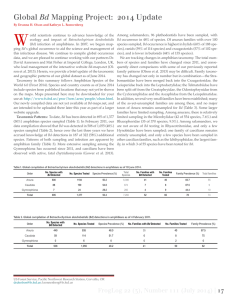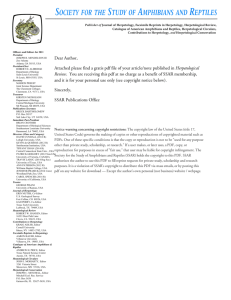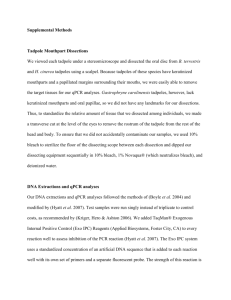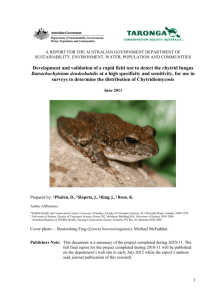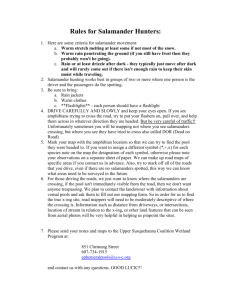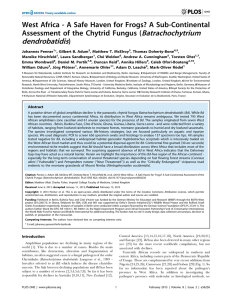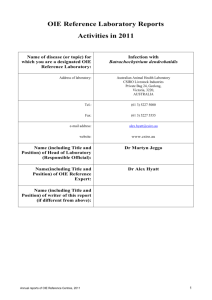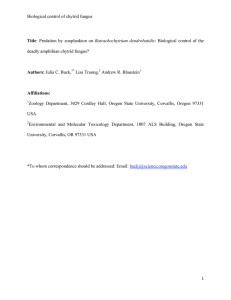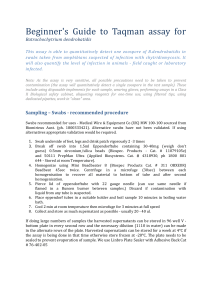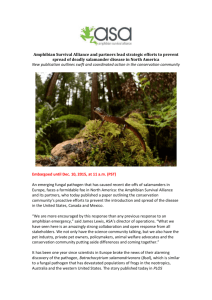Dear Author, Attached please find a gratis pdf file of your article/note
advertisement
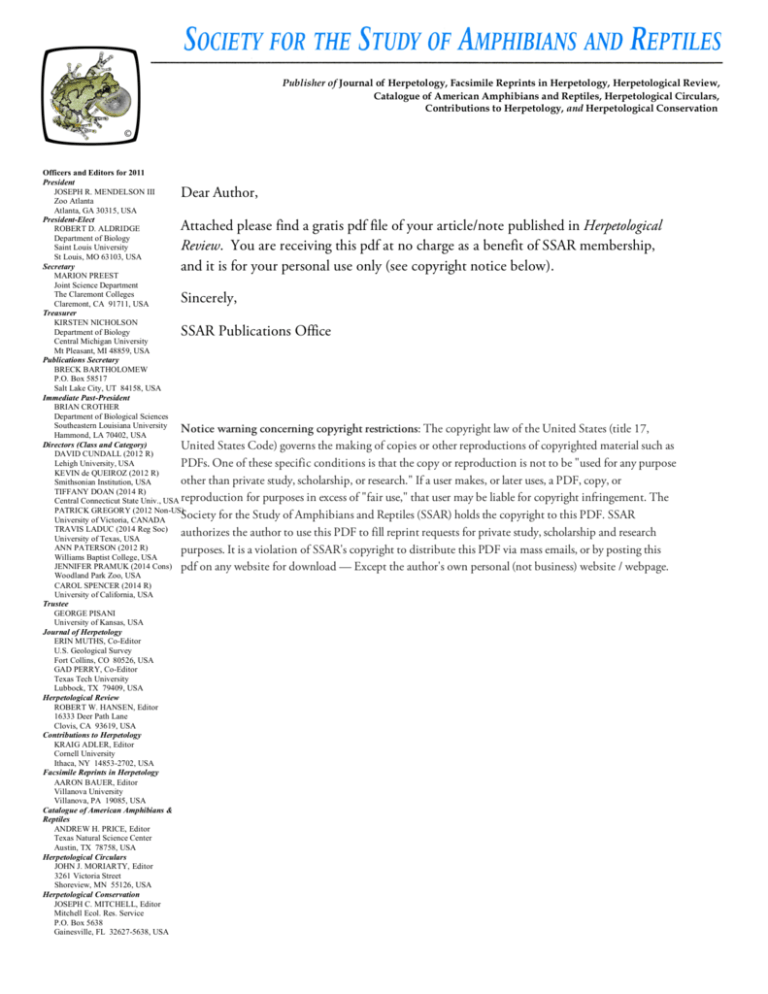
Publisher of Journal of Herpetology, Facsimile Reprints in Herpetology, Herpetological Review, Catalogue of American Amphibians and Reptiles, Herpetological Circulars, Contributions to Herpetology, and Herpetological Conservation Officers and Editors for 2011 President JOSEPH R. MENDELSON III Zoo Atlanta Atlanta, GA 30315, USA President-Elect ROBERT D. ALDRIDGE Department of Biology Saint Louis University St Louis, MO 63103, USA Secretary MARION PREEST Joint Science Department The Claremont Colleges Claremont, CA 91711, USA Treasurer KIRSTEN NICHOLSON Department of Biology Central Michigan University Mt Pleasant, MI 48859, USA Publications Secretary BRECK BARTHOLOMEW P.O. Box 58517 Salt Lake City, UT 84158, USA Immediate Past-President BRIAN CROTHER Department of Biological Sciences Southeastern Louisiana University Notice warning concerning copyright restrictions: The copyright law of the United States (title 17, Hammond, LA 70402, USA Directors (Class and Category) United States Code) governs the making of copies or other reproductions of copyrighted material such as DAVID CUNDALL (2012 R) Lehigh University, USA PDFs. One of these specific conditions is that the copy or reproduction is not to be "used for any purpose KEVIN de QUEIROZ (2012 R) other than private study, scholarship, or research." If a user makes, or later uses, a PDF, copy, or Smithsonian Institution, USA TIFFANY DOAN (2014 R) Central Connecticut State Univ., USA reproduction for purposes in excess of "fair use," that user may be liable for copyright infringement. The PATRICK GREGORY (2012 Non-US) Society for the Study of Amphibians and Reptiles (SSAR) holds the copyright to this PDF. SSAR University of Victoria, CANADA TRAVIS LADUC (2014 Reg Soc) authorizes the author to use this PDF to fill reprint requests for private study, scholarship and research University of Texas, USA ANN PATERSON (2012 R) purposes. It is a violation of SSAR's copyright to distribute this PDF via mass emails, or by posting this Williams Baptist College, USA JENNIFER PRAMUK (2014 Cons) pdf on any website for download — Except the author's own personal (not business) website / webpage. Woodland Park Zoo, USA CAROL SPENCER (2014 R) University of California, USA Trustee GEORGE PISANI University of Kansas, USA Journal of Herpetology ERIN MUTHS, Co-Editor U.S. Geological Survey Fort Collins, CO 80526, USA GAD PERRY, Co-Editor Texas Tech University Lubbock, TX 79409, USA Herpetological Review ROBERT W. HANSEN, Editor 16333 Deer Path Lane Clovis, CA 93619, USA Contributions to Herpetology KRAIG ADLER, Editor Cornell University Ithaca, NY 14853-2702, USA Facsimile Reprints in Herpetology AARON BAUER, Editor Villanova University Villanova, PA 19085, USA Catalogue of American Amphibians & Reptiles ANDREW H. PRICE, Editor Texas Natural Science Center Austin, TX 78758, USA Herpetological Circulars JOHN J. MORIARTY, Editor 3261 Victoria Street Shoreview, MN 55126, USA Herpetological Conservation JOSEPH C. MITCHELL, Editor Mitchell Ecol. Res. Service P.O. Box 5638 Gainesville, FL 32627-5638, USA Dear Author, Attached please find a gratis pdf file of your article/note published in Herpetological Review. You are receiving this pdf at no charge as a benefit of SSAR membership, and it is for your personal use only (see copyright notice below). Sincerely, SSAR Publications Office AMphibian Diseases characteristics such as a septum and discharge tube (Fig. 2), and hyperplasic epidermis. It is worth mentioning that the population of P. fernandezae used in this study has been studied by local herpetologists since 2001, but no moribund or dead specimens have been recorded to date. Moreover, the individuals on which infection was detected had been engaged in reproductive activities. Acknowledgments.—We are grateful to Josefina V. Candioti and Marcelo L. Larramendy for use of their microscope and digital camera. We thank Allan P. Pessier for his critical review of the photos. Literature Cited Arellano, M. L., D. P. Ferraro, M. M. Steciow, and E. O. Lavilla. 2009. Infection by the chytrid fungus Batrachochytrium dendrobatidis in the yellow belly frog (Elachistocleis bicolor) from Argentina. Herpetol. J. 19:217–220. Barrio, A. 1964. Relaciones morfológicas, eto-ecológicas y zoogeográficas entre Physalaemus henseli (Peters) y P. fernandezae (Müller) (Anura, Leptodactylidae). Acta Zool. Lilloana 20:285–305. Barrionuevo, S., and S. Mangione. 2006. Chytridiomycosis in two species of Telmatobius (Anura: Leptodactylidae) from Argentina. Dis. Aquat. Org. 73:171–174. Berger, L., R. Speare, and A. Kent. 1999. Diagnosis of chytridiomycosis in amphibians by histologic examination. Available at: www.jcu. 85 edu.au/school/phtm/PHTM/frogs/histo/chhisto.htm. November 1999. Drury, R. B., and E. A. Wallington. 1980. Carleton’s Histological Technique. Oxford University Press. 520 pp. Fox, S., J. Yoshioka, M. E. Cuello, and C. Úbeda. 2006. First case of ranavirus-associated morbidity and mortality in natural populations of the South American frog Atelognathus patagonicus. Dis. Aquat. Org. 72:87–92. Ghirardi, R., J. N. Lescano, M. S. Longo, G. Robledo, M. M. Steciow, and M. G. Perotti. 2009. Batrachochytrium dendrobatidis in Argentina: first record in Leptodactylus gracilis and another record in Leptodactylus ocellatus. Herpetol. Rev. 40:175–176. Gutierrez, F. R., M. L. Arellano, L. E. Moreno, and G. S. Natale. 2010. Batrachochytrium dendrobatidis in Argentina: First record of infection in Hypsiboas cordobae and Odontophrynus occidentalis tadpoles, in San Luis province, Argentina. Herpetol. Rev. 41:323– 325. Herrera, R., M.M. Steciow, and G.S. Natale. 2005. Chytrid fungus parasitizing the wild amphibian Leptodactylus ocellatus (Anura: Leptidactylidae) in Argentina. Dis. Aquat. Org. 64:247–252. IUCN [International Union for the Conservation of Nature]. 2011. IUCN Red List of Threatened Species. Available at: www.iucnredlist.org. Accessed 06 August 2011. SMN [Servicio Meteorológico Nacional]. 2011. Valores medios de temperatura y precipitación (1961–1990). Climatología. Productos elaborados. Available at: http://www.smn.gov.ar. Accessed 11 August 2011. Herpetological Review, 2012, 43(1), 85–87. © 2012 by Society for the Study of Amphibians and Reptiles Low Prevalence of Batrachochytrium dendrobatidis in Two Plethodontid Salamanders from North Carolina, USA Although the pathogenic fungus Batrachochytrium dendrobatidis (Bd) was first isolated from anuran amphibians, subsequent research has clearly shown that it also infects many species of caudate amphibians. Opportunistic sampling surveys have shown that at least 56 species of salamanders from the families Ambystomatidae, Amphiumidae, Salamandridae, Crytobranchidae, and Plethodontidae in the United States harbor Bd (reviewed in Bryne et al. 2008; Olson 2010). The effect of Bd on salamander demography, however, is less understood than its impact on anuran populations. Laboratory challenge experiments have shown that salamanders can be infected by Bd and show mortality from chytridiomycosis (Chinnadurai et al. 2009; Vazquez et al. 2009; Weinstein 2009), but more sampling and monitoring of salamanders will help elucidate potential ecological and/or climatic variables that may influence the susceptibility of salamanders in the wild. Here, we contribute information on the prevalence and distribution of Bd in salamander populations by testing 166 individuals from two localities in North Carolina, USA. Our results expand upon previous reports of Bd infection in amphibian populations in North Carolina (e.g., Bryne et al. 2009; Keitzer et al. 2011; Rothermel et al. 2008). We opportunistically sampled two plethodontid salamander species at two collection sites on 8–12 August 2010 (Fig. 1). At Deep Gap, we collected salamanders by turning over rocks and logs that were located up to 15 m from a stream. The collecting site at Wayah Bald was a grassy area near the forest edge. We swabbed each salamander 30 times using sterile swabs (Medical wire No. 113) in the manner of Boyle et al. (2004) and Kriger et al. (2006). Each animal was handled with a clean pair of latex gloves. No animals showed any outward signs of disease. After swabbing, animals were retained for additional studies under permits issued by the North Carolina Wildlife Resources Commission and the U.S. Forest Service to LDH. Swabs were stored in 100% ethanol and transported to Cornell University, where molecular testing was performed by Kiemnec-Tyburczy. Genomic DNA was extracted from the swabs using Prepman Ultra following the protocol of Boyle et al. (2004). The level of Bd zoospore load was assessed using the method of Boyle et al. (2004). Briefly, this method used Taqman quantitative PCR to determine the total number of Bd zoospore genome equivalents in each unknown sample, based on known standards that were run simultaneously. To maximize cost efficiency but retain individual information, PCRs were run in singlicates at 1:10 Karen M. Kiemnec-Tyburczy* Department of Ecology and Evolutionary Biology, Cornell University E145 Corson Hall, Ithaca, New York 14853, USA Sarah L. Eddy Adam J. Chouinard Lynne D. Houck Department of Zoology, Oregon State University, 3029 Cordley Hall Corvallis, Oregon 97331, USA *Corresponding author; e-mail: kmk255@cornell.edu Herpetological Review 43(1), 2012 86 AMphibian Diseases interval) for each site using Clopper-Pearson binomial confidence intervals (Clopper and Pearson 1934). We found that 9 of 166 (5.4%) animals tested positive for Bd. Both species—Desmognathus ocoee and Plethodon shermani— had Bd-positive individuals (Table 1). Plethodon shermani is a direct-developing species that is commonly found under leaf litter, logs, and rocks. In contrast, D. ocoee has an aquatic larval stage and often is associated with seepages and streams (and thus may be more likely to come in contact with Bd zoospores). Despite these differences in life histories, both species had similar Bd prevalence levels. To our knowledge, this is the first published report of Bd infecting these two species, although Keitzer et al. (2011) tested one P. shermani and 53 D. ocoee at Coweeta Hydrologic Laboratory (Macon Co., North Carolina) but did not detect Bd on any individuals. We note, however, that our sampling occurred slightly later in the year and may have occurred at higher elevations. The elevation of our two localities, Deep Gap and Wayah Bald—approximately 1300 m and 1630 m, respectively—are in the upper end of the elevation range of the Coweeta area that was sampled (675–1592 m), and thus our localities may have been cooler and perhaps more suitable for Bd. The prevalence of Bd at Deep Gap was 0.050 (95% CI: 0.016– 0.11), whereas the prevalence at Wayah Bald was slightly higher at 0.061 (95% CI: 0.017–0.15). All of the zoospore loads we quantified were very low. The highest load we calculated was 57 zoospores, and most of the positive samples contained 3–4 zoospores (range 1–57 zoospores). We did not observe any trend towards particular life stages or sexes being infected within the two species (Table 1), although the animal with the highest load was a juvenile P. shermani from Wayah Bald. The low levels of prevalence, combined the lack of clinical signs of disease, suggests that Bd exists primarily as a subclinical infection in D. ocoee at Deep Gap and in P. shermani at Wayah Bald, at least during the summer months. Our data are consistent with other studies of plethodontid populations that have shown that Bd prevalence in some populations is relatively low, but that Bd is present in North Carolina (e.g., Keitzer et al. 2011; Rothermel et al. 2008). Bd also has been found in other species of Plethodon and Desmognathus in other areas of the USA. Prevalence in P. glutinosus and P. yonahlossee in Watauga County, North Carolina was 1/40 and 1/41, respectively (Chinnadurai et al. 2009). Desmognathus conanti Fig 1. Specific location and topography of two sites in North Caroli(Timpe et al. 2008) and D. fuscus (Grant et al. 2008) have also na, USA (inset; shaded state), where salamanders were tested for the tested positive for Bd. In fact, Bd has been found on plethodonpresence of Batrachochytrium dendrobatidis (Bd). DG = Deep Gap, tid species as diverse as Pseudotriton ruber (Montanucci 2009), WB = Wayah Bald. Batrachoseps attenuatus (Weinstein 2009), Bolitoglossa dofleini (Pasmans et al. 2004) and Plethodon neomexicanus (Cummer et al. 2005). In other salamander families, population surveys Table 1. Batrachochytrium dendrobatidis (Bd) prevalence (number of have reported varying estimates of prevalence. A survey of NoBd-positive animals/total sampled) in plethodontid salamanders in tophthalmus viridescens found 16 of 63 individuals infected in North Carolina, USA. localities in Georgia, North Carolina, and Virginia (Rothermel Prevalence et al. 2008), whereas another found prevalence in N. viridescens LocalitySpecies ♀ ♂ JuvenileTotal varied between 0–100% across multiple ponds in Pennsylvania (Groner and Relyea 2010). Prevalence in ambystomatid salaDeep Gap manders also varies widely; Ouellet et al. (2005) found 4/139 (35.0389°N, Desmognathus ocoee 1/23 1/31 2/16 4/70 Ambystoma maculatum infected across Canada while Padgett83.5431°W) Plethodon shermani 1/11 0/6 0/13 1/30 Flohr and Longcore (2005) found 2/11 A. californiense infected in two ponds. These studies highlight the need for further work Wayah Bald investigating how disease-related mortality has impacted natu(35.1803°N, Desmognathus ocoee0/1 0/0 0/0 0/1 ral populations historically. Further testing across multiple sea83.5606°W) Plethodon shermani 1/26 2/14 1/25 4/65 sons and years is necessary to better understand Bd infection dynamics in salamanders. dilutions. Studies have shown that there is no statistical difference in sensitivity or specificity between the singlicate and triplicate assays (Kriger et al. 2006). Every swab sample was run with (1) two negative controls, (2) an internal positive control (ABI Cat. No. 4308323) to test for potential inhibition and contamination, and (3) a range of Bd standards corresponding to 0.1, 1, 10, and 100 and 1000 zoospore DNA equivalents in duplicate (Hyatt et al. 2007). Samples that were positive for Bd in the first round of qPCR were re-run to confirm loads using the same template dilution. We categorized an individual as Bd-positive if its swab sample had ≥ 1 zoospore equivalent in both runs (Boyle et al. 2004). We calculated a mean prevalence (and 95% confidence Herpetological Review 43(1), 2012 AMphibian Diseases Acknowledgments.—We thank Corina Wack, Kari Leichty and Damien Wilburn for assistance with swab collection; Ana Longo for help with qPCR protocol optimization; and David Rodriguez and Kelly Christiansen for creating the locality figure. The protocols were approved by the Cornell University Institutional Animal Care and Use Committee. This study was funded by a National Science Foundation grant to KMK and LDH (IOS-0808589). Literature Cited Boyle, D. G., D. B. Boyle, V. Olsen, J. A. T. Morgan, and A. D. Hyatt. 2004. Rapid quantitative detection of chytridiomycosis (Batrachochytrium dendrobatidis) in amphibian samples using real-time Taqman PCR assay. Dis. Aquat. Org. 60:141–148. Byrne, M. W., P. D. Emily, and J. W. Gibbons. 2008. Batrachochytrium dendrobatidis occurrence in Eurycea cirrigera. Southeast. Nat. 7:551–555. Chinnadurai, S. K., D. Cooper, D. S. Dombrowski, M. F. Poore, and M. G. Levy. 2009. Experimental infection of native North Carolina salamanders with Batrachochytrium dendrobatidis. J. Wildl. Dis. 45:631–636. Clopper, C. J., and E. S. Pearson. 1934. The use of confidence or fiducial limits illustrated in the case of the binomial. Biometrika 26:404– 413. Cummer, M. R., D. E. Green, and E. M. O’Neil. 2005. Aquatic chytrid pathogen detected in terrestrial plethodontid salamander. Herpetol. Rev. 36:248–249. Grant, E. H. C., L. L. Bailey, J. L. Ware, and K. L. Duncan. 2008. Prevalence of the amphibian pathogen Batrachochytrium dendrobatidis in stream and wetland amphibians in Maryland, USA. Applied Herpetol. 5:233–241. Groner, M. L., and R. A. Relyea. 2010. Batrachochytrium dendrobatidis is present in northwest Pennsylvania, USA, with high prevalence in Notophthalmus viridescens. Herpetol. Rev. 41:462–465. Hyatt, A. D., D. G. Boyle, V. Olsen, D. B. Boyle, L. Berger, D. Obendorf, A. Dalton, K. Kriger, M. Hero, H. Hines, R. Phillot, R. Campell, G. Marantelli, F. Gleason, and A. Colling. 2007. Diagnostic assays and sampling protocols for the detection of Batrachochytrium dendrobatidis. Dis. Aquat. Org. 73:175–192. 87 Keitzer, S. C., R. Goforth, A. P. Pessier, and A. J. Johnson. 2011. Survey for the pathogenic chytrid fungus Batrachochytrium dendrobatidis in southwestern North Carolina salamander populations. J. Wildl. Dis. 47: 455–458. Kriger, K. M., J. M. Hero, and K. J. Ashton. 2006. Cost efficiency in the detection of chytridiomycosis using PCR assay. Dis. Aquat. Org. 71:149–154. Montanucci, R. R. 2009. The chytrid fungus in the red salamander, Pseudotriton ruber, in South Carolina, USA. Herpetol. Rev. 40:188. Olson, D. H. 2010. Global Batrachochytrium dendrobatidis Mapping Project. http://www.parcplace.org/news-a-events/207-globalbd-mapping-project-update-7-july-2010.html Ouellet, M., I. Mikaelian, B.D. Pauli, J. Rodrigue, and D.M. Green. 2005. Historical evidence of widespread chytrid infection in North American amphibian populations. Cons. Biol. 19:1431–1440. Padgett-Flohr, G.E., and J.E. Longcore. 2005. Ambystoma californiense (California Tiger Salamander). Fungal infection. Herpet. Rev. 36:50–51. Pasmans, R., R. Zwart, and A. D. Hyatt. 2004. Chytridiomycosis in the Central American Bolitoglossine salamander (Bolitoglossa dofleini). Vet. Rec. 154:153. Rothermel, B. B., S. C. Walls, J. C. Mitchell, C. K. Dodd, L. K. Irwin, D. E. Green, V. M. Vazquez, J. W. Petranka, and D. J. Stevenson. 2008. Widespread occurrence of the amphibian chytrid fungus Batrachochytrium dendrobatidis in the southeastern USA. Dis. Aquat. Org. 82:3–18. Timpe, E. K., S. P. Graham, R. W. Gagliardo, R. L. Hill, and M. G. Levy. 2008. Occurrence of the fungal pathogen Batrachochytrium dendrobatidis in Georgia’s amphibian populations. Herpetol. Rev. 39:447–449. Vazquez, V. M., B. B. Rothermel, and A. P. Pessier. 2009. Experimental infection of North American plethodontid salamanders with the fungus Batrachochytrium dendrobatidis. Dis. Aquat. Org 84:1–7. Weinstein, S. B. 2009. An aquatic disease on a terrestrial salamander: individual and population level effects of the amphibian chytrid fungus, Batrachochytrium dendrobatidis, on Batrachoseps attenuatus (Plethodontidae). Copeia 2009:653–660. Herpetological Review, 2012, 43(1), 87–89. © 2012 by Society for the Study of Amphibians and Reptiles Detection of Batrachochytrium dendrobatidis in Amphibian Populations of Northeast Ohio The first North American occurrence of Batrachochytrium dendrobatidis (Bd) was documented in Quebec in 1961 (Ouellet et al. 2005). As of 2009, Bd had been detected in five Canadian provinces and at least 38 US states (for example, Hossack et al. 2010; Sadinski et al. 2010; Fisher et al. 2009; Slough 2009; Muths et al. 2008; Rothermel et al. 2008; Adams et al. 2007; Longcore et al. 2007; Steiner and Lehtinen 2007; Ouellet et al. 2005, and many others, see www.Bd-maps.net). In Ohio, Bd has been detected via PCR analysis in wild Northern Leopard Frogs (Lithobates pipiens), American Toads (Anaxyrus americanus) (Scott and Sheafor, unpubl.), and Blanchard’s Cricket Frogs (Acris blanchardi) (Steiner and Lehtinen 2008). In addition, Fowler’s Toads (Anaxyrus fowleri) and cricket frogs captured in Ohio and held at the Toledo Zoo were later found to be infected with Bd (G. Lipps, pers. comm.). It is uncertain, however, whether these animals were infected prior to arriving at the zoo, or if they contracted it from other infected species already present at the zoo. Histological surveys of Fowler’s Toad museum specimens originally collected from Ashtabula County, Ohio in 1977 determined that the samples were Bd-positive (Scott and Sheafor, unpubl.), indicating that Bd has been in the northeastern Ohio region for at least three decades. Because Bd has been detected in field-collected amphibians from northeast Ohio, the possibility exists that the Timothy J. Krynak * Terry L. Robison Cleveland Metroparks, 4101 Fulton Parkway, Cleveland, Ohio 44144, USA Jonathan J. Scott University of Mount Union, Academic Affairs, Biology Department, Alliance, Ohio 44601, USA *Corresponding author; e-mail: tjk@clevelandmetroparks.com Herpetological Review 43(1), 2012

